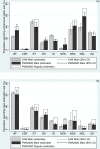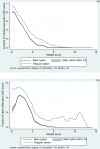Underreporting of high-risk water and sanitation practices undermines progress on global targets
- PMID: 28489904
- PMCID: PMC5425011
- DOI: 10.1371/journal.pone.0176272
Underreporting of high-risk water and sanitation practices undermines progress on global targets
Abstract
Water and sanitation indicators under the Millennium Development Goals failed to capture high-risk practices undertaken on a regular basis. In conjunction with local partners, fourteen rounds of household surveys using mobile phones with a customized open-source application were conducted across nine study geographies in Asia and Africa. In addition to the main water and sanitation facilities, interviewees (n = 245,054) identified all water and sanitation options regularly used for at least one season of the year. Unimproved water consumption and open defecation were targeted as high-risk practices. We defined underreporting as the difference between the regular and main use of high-risk practices. Our estimates of high-risk practices as the main option matched the widely accepted Demographic and Health Surveys (DHS) estimates within the 95% confidence interval. However, estimates of these practices as a regular option was far higher than the DHS estimates. Across the nine geographies, median underreporting of unimproved water use was 5.5%, with a range of 0.5% to 13.9%. Median underreporting of open defecation was much higher at 9.9%, with a range of 2.7% to 11.5%. This resulted in an underreported population of 25 million regularly consuming unimproved water and 50 million regularly practicing open defecation. Further examination of data from Ethiopia suggested that location and socio-economic factors were significant drivers of underreporting. Current global monitoring relies on a framework that considers the availability and use of a single option to meet drinking water and sanitation needs. Our analysis demonstrates the use of multiple options and widespread underreporting of high-risk practices. Policies based on current monitoring data, therefore, fail to consider the range of challenges and solutions to meeting water and sanitation needs, and result in an inflated sense of progress. Mobile surveys offer a cost-effective and innovative platform to rapidly and repeatedly monitor critical development metrics.
Conflict of interest statement
Figures




Similar articles
-
Trends in access to water supply and sanitation in 31 major sub-Saharan African cities: an analysis of DHS data from 2000 to 2012.BMC Public Health. 2014 Feb 28;14:208. doi: 10.1186/1471-2458-14-208. BMC Public Health. 2014. PMID: 24576260 Free PMC article.
-
What works in water supply and sanitation projects in developing countries with EWB-USA.Rev Environ Health. 2016 Mar;31(1):85-7. doi: 10.1515/reveh-2015-0043. Rev Environ Health. 2016. PMID: 26812847
-
Geospatial distribution of unimproved water source and sanitation facilities in Ethiopia: evidence from the latest demographic and health survey (2019).Sci Rep. 2025 Jan 2;15(1):255. doi: 10.1038/s41598-024-82688-x. Sci Rep. 2025. PMID: 39747913 Free PMC article.
-
Community health outreach program of the Chad-Cameroon petroleum development and pipeline project.Clin Occup Environ Med. 2004 Feb;4(1):9-26. doi: 10.1016/j.coem.2003.09.004. Clin Occup Environ Med. 2004. PMID: 15043361 Review.
-
Improving access to adequate water and basic sanitation services in Indonesia.Rev Environ Health. 2012;27(4):159-62. doi: 10.1515/reveh-2012-0022. Rev Environ Health. 2012. PMID: 23095182 Review.
Cited by
-
The prevalence of schistosomiasis in Uganda: A nationally representative population estimate to inform control programs and water and sanitation interventions.PLoS Negl Trop Dis. 2019 Aug 14;13(8):e0007617. doi: 10.1371/journal.pntd.0007617. eCollection 2019 Aug. PLoS Negl Trop Dis. 2019. PMID: 31412023 Free PMC article.
-
Sanitation facilities, hygienic conditions, and prevalence of acute diarrhea among under-five children in slums of Addis Ababa, Ethiopia: Baseline survey of a longitudinal study.PLoS One. 2017 Aug 30;12(8):e0182783. doi: 10.1371/journal.pone.0182783. eCollection 2017. PLoS One. 2017. PMID: 28854200 Free PMC article.
-
Access to Drinking Water, Sanitation, and Hand Hygiene Facilities in the Peri-Urban and Informal Settlements of Hosanna Town, Southern Ethiopia.Environ Health Insights. 2023 Aug 29;17:11786302231193604. doi: 10.1177/11786302231193604. eCollection 2023. Environ Health Insights. 2023. PMID: 37655235 Free PMC article.
-
Prevalence of acute diarrhea and associated factors among children under five in semi-urban areas of northeastern Ethiopia.BMC Pediatr. 2021 Jun 26;21(1):290. doi: 10.1186/s12887-021-02762-5. BMC Pediatr. 2021. PMID: 34174851 Free PMC article.
-
Water, sanitation, and hygiene conditions and prevalence of intestinal parasitosis among primary school children in Dessie City, Ethiopia.PLoS One. 2021 Feb 3;16(2):e0245463. doi: 10.1371/journal.pone.0245463. eCollection 2021. PLoS One. 2021. PMID: 33534792 Free PMC article.
References
-
- Bartram J., & Cairncross S. (2010). Hygiene, sanitation, and water: forgotten foundations of health. PLoS Med, 7(11), e1000367 doi: 10.1371/journal.pmed.1000367 - DOI - PMC - PubMed
-
- United Nations. (2000). United Nations Millennium Declaration, United Nations General assembly, New York, 18 September, available at http://www.un.org/millennium/declaration/ares552e.htm
-
- Gates, B. (2008). Speech at the United Nations General Assembly. September 25. Available at: http://www.gatesfoundation.org/media-center/speeches/2008/09/bill-gates-...
-
- Gates B. (2013). Annual Letter 2013. Bill & Melinda Gates Foundation; January Available at: http://www.gatesfoundation.org/Who-We-Are/Resources-and-Media/Annual-Let...
-
- Bain R. E., Gundry S. W., Wright J. A., Yang H., Pedley S., & Bartram J. K. (2012). Accounting for water quality in monitoring access to safe drinking-water as part of the Millennium Development Goals: lessons from five countries. Bulletin of the World Health Organization, 90(3), 228–235. doi: 10.2471/BLT.11.094284 - DOI - PMC - PubMed
MeSH terms
LinkOut - more resources
Full Text Sources
Other Literature Sources
Medical

